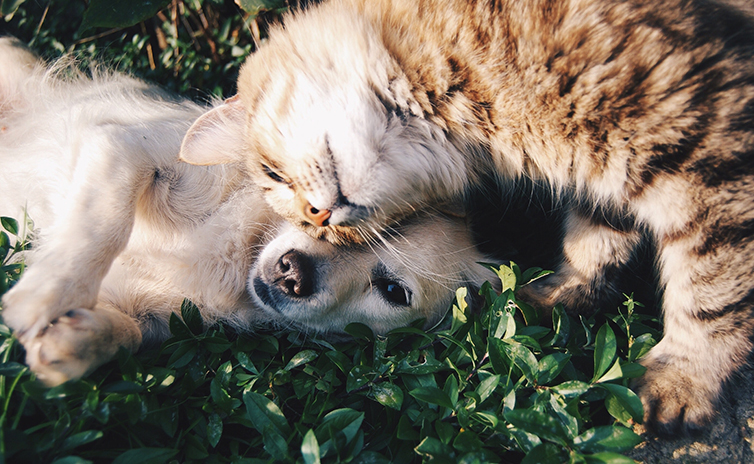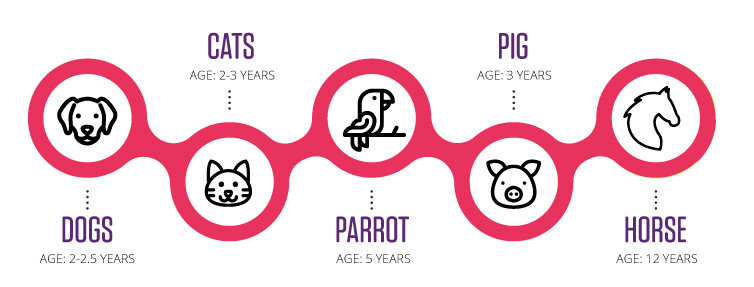Do our pets feel emotions?
As avid pet lovers, we are quick to defend our furry friends when others question their ability to feel emotions. But are those tell-tale signs of happiness, such as dogs wagging their tails or cats purring, really an expression of emotion or simple behavioural responses? Bravecto® has done the legwork to answer that age-old question – do pets have feelings?
HEALTH AND WELLNESS

Posted by bravectosouthafrica – 04 February 2021
Historical study of pet emotions

We all remember Pythagoras from high school maths. He was an ancient philosopher and mathematician who also studied animals. Pythagoras believed that animals have the same range of emotions as humans and this was way back in the 4th century BC.
More recently, Charles Darwin (pictured above), an English naturalist, geologist and biologist, best known for his contributions to the science of evolution, stated that “there is no fundamental difference between man and the higher mammals in their mental facilities.”
Despite these theories, the rise of science sparked questions and doubts as man started to understand physics and mechanics. If we could create life-changing technologies with our mental prowess, how could animals with the same mental function not do the same?
At this point in history, the church stepped in to argue that humans have souls and animals do not, citing our ability to have consciousness and feelings as evidence. And as most literature of that time and going forward was written by church scholars, the theory that animals have emotions became an unpopular one.
French philosopher, Descartes, took this theory one step further describing animals as machines with basic functions, not emotions. He said that they “eat without pleasure, cry without pain, act without knowing it: they desire nothing, fear nothing, know nothing.”
Many animal lovers would be offended at this suggestion especially having witnessed the euphoria of a dog with a bone or a cat being stroked gently.
Luckily modern science has made a lot of headway since the days of Descartes with compelling evidence that some animals feel a full range of emotions including fear, joy, happiness, shame, embarrassment, resentment, jealousy, anger, love, pleasure, compassion, respect, relief, sadness and grief.
What we know now

Science has now shown that many animals (dogs and cats included) have the same brain structures that humans use to produce emotions. They even have the same chemical reactions in the brain during emotional states including the hormone oxytocin, or the happy chemical which produces feelings of love and affection.
So if pets have the same brain chemicals and neurology as us, it’s fair to say that they certainly do feel emotions – but to what extent?
How to study animal feelings

One of the biggest challenges facing scientists who want to study animal emotions is animals’ inability to tell us how they are feeling. But just because they cannot explain it, doesn’t mean that they don’t feel it.
One could argue that human emotions are also not scientific – you cannot measure a person’s happiness or understand another’s sadness using facts. The same applies to pets because their emotions are not necessarily observable, measurable, and verifiable. For this reason, scientists use both factual studies as well as documented anecdotes to try to understand how and why animals act a certain way. So instead of confining animals to a laboratory to conduct tests, they observe them in a natural environment and study exceptional cases of clear emotional demonstration.
The study of emotions

The understanding of emotions themselves has evolved over time. Historically, certain emotional states that we describe today did not exist because people didn’t know how to express them.
In addition, emotions develop as a person gets older. Studies show that toddlers have a very limited range of emotions which develops, with their personality, over time and personal growth. This fact does not apply to pets. Their emotional development can be related to that of a human child which may give us a better understanding of how to deal with them.
If your pet is misbehaving perhaps you could ask yourself how you would respond to a toddler – without expecting them to understand your language of course.
The mental age of your pet

Relating your pet’s mental age to that of a child is a step forward in understanding how and why they react as they do. Below are the estimated mental ages of certain pet species.

By looking at the above estimated child age equivalents, it is clear that pets do have the ability to feel emotions, just not as many different types of emotions as adult humans. If we think of a baby at birth, they only have an emotion similar to that of excitement. They are either very calm (or sleeping) or completely frenzied up when they need something. Over the first few weeks, babies begin to develop these emotions into positive and negative ones specifically contentment and distress. A few months later and we begin to see fear, anger and even disgust at that spoonful of mom’s special homemade baby food. At six months, we begin to see joy as baby smiles but true affection only emerges around nine or ten months.
The rest of the emotional spectrum must be learned – most from social engagement. At three years old, we see shame and pride in children. Contempt takes four years to develop. By the time a child is four years old, they have already surpassed the emotional capacity of a dog and cat.
So what emotions do pets actually feel?

Dogs develop physically and emotionally far faster than human babies. Their full range of emotions is developed by four to six months old depending on the breed. This range does not exceed that of a two to two-and-a-half-year-old child. Dogs have basic emotions such as joy, fear, anger, disgust and love, of course.
But dogs do not have complex emotions like pride and shame even if they do look guilty after ripping your favourite cushion to pieces. Scientists have discovered that this reaction is actually a manifestation of fear. The dog has learnt that you react angrily to destruction and is fearful of his punishment – he is not showing guilt because he is not developed enough to feel it.
Cats are very similar. In 2008, a study showed that pet owners believe their cats to feel curiosity, joy and fear most while guilt, shame and embarrassment were the least likely emotions. Like dogs, a cat’s fear reaction is sometimes mistaken for guilt.
Dog and cat owners may believe that their pet displays jealous traits. This is in fact an instinctual reaction to “territory” which may even include you. If your dog pushes between you and another pet it is because he feels the need to compete for a scarce resource.
Unfortunately, both dogs and cats can also experience emotions such as depression and anxiety when their needs are not being met or they feel insecure.
Factors affecting negative pet emotions

You’re already an expert on what makes your pet happy because their joyfulness is also a means to relieve our own negative emotions. But what makes our cat or dog experience negative emotions?
Veterinarians are not sure if dogs experience the same kind of depression as humans but the symptoms can be similar. The challenge in studying this is that we cannot ask a dog how it feels.
Studies show that periods of change are usually to blame for a dog feeling down and it is unlikely for a dog to be depressed for an extended period. Owners have noted clear signs of depression in dogs when another dog in the household passes but this is usually only a short-lived episode.
Signs of depression in dogs include withdrawal, inactivity, changes in eating and sleeping patterns and disinterest in things they used to enjoy.
Often the cause of this depression is medical which is why vets advise seeking a professional opinion if your dog has been down for more than a few days. Your dog’s apparent sadness could be the result of a painful medical condition such as arthritis.
A cat’s depression will have similar symptoms to that of a dog but may also include poor grooming habits, changes in vocalization, excessive scratching or “spraying”. Like dogs, the causes can include illness, injury or loss of a loved one.
If your pet is showing signs of prolonged negative behaviour, it is advisable to seek the opinion of a vet.
BRAVECTO® CAN PREVENT PEST-DEPRESSION

Also, make sure your tick and flea treatment is up to date. The constant harassment of fleas can affect your pet’s all-round contentment, and disturbances to sleep patterns can also result in depression. Choose a treatment like Bravecto® which protects your dog and cat for up to 3 months against ticks, fleas and mites.
A healthy pet is usually a happy pet and a happy pet can greatly affect the happiness of you, the pet parent.
Subscribe to our Newsletter
Get to know your furry friend better! Sign up for all things dog- or cat-related.
The Hairy Facts about the dreaded hairball
12 April 2021
Help! My dog’s barking mad! Volume 2
12 April 2021
Your Itchy, Scratchy Cat – All About Cat Skin Problems
12 April 2021
The Dog’s Diet: A Bone of contention?
01 April 2021
Mango Fly Worms: How to Spot and Eliminate them
Posted on November 28,2019
Managing Mange And Mites In Your Dog
Posted on June 11,2018
Why Do Cats Purr and How? Learn What Your Cat Is Saying
Posted on October 14,2020
How to Get Rid of Ear Mites in Dogs
Posted on November 06,2019









